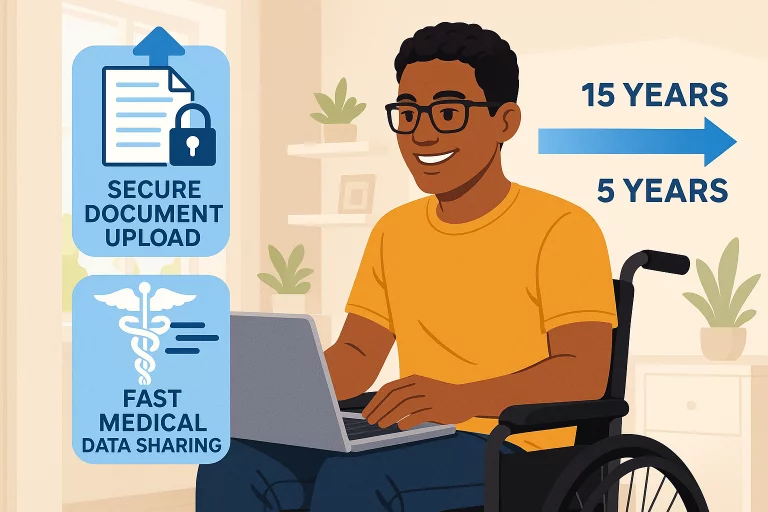Key Takeaways
- The Social Security Administration (SSA) has reduced the work history review period from 15 to 5 years, easing the application process for claimants and making it more relevant to their current abilities.
- Online applications for Supplemental Security Income (SSI) are now available, offering faster, more accessible, and less burdensome claims submission processes, particularly for individuals with mobility challenges.
- Healthcare providers are collaborating closely with SSA to facilitate the rapid and secure electronic sharing of medical records, thereby enhancing both the accuracy and speed of claim decisions.
Introduction to Streamlining Disability Benefits
The Social Security Administration (SSA) has implemented policy changes and technological innovations to improve the process of securing disability benefits. This change aims to dismantle outdated hurdles, replace them with intuitive interfaces, clearer communication, and rapid processing. Expert help with VA medical claims for veterans is also being utilized, providing personalized guidance and critical support. This modernization is characterized by regulatory flexibility and broad adoption of digital tools, aiming to empower claimants at every stage. Understanding these improvements is crucial for applicants and their families to navigate the evolving system with confidence and secure benefits more efficiently. Staying informed about the latest SSA initiatives and available supports can significantly impact outcomes.
Reducing the Work History Review Period
The Social Security Administration (SSA) has reduced the work history evaluation period from 15 years to just 5 years, reducing the workload for applicants. Previously, applicants had to document a decade and a half of their employment, which was overwhelming and sometimes resulted in incomplete or inconsistent reporting. Effective June 22, 2024, the policy now instructs SSA staff to focus on the most recent five years of a claimant’s employment record. It makes the submission of work history more manageable, ensuring accurate information and fairer outcomes. The narrower review period also increases efficiency for decision-makers.
Embracing Online Applications
The shift towards online disability claims processing is a significant advancement in accessbility and efficiency. The digital applications for Supplemental Security Income (SSI) eliminate the frustration of traditional paperwork and in-person visits. The platform minimizes questions, populates information from existing records, and uses smart prompts to guide applicants. It is particularly beneficial for individuals with mobility limitations, health challenges, or limited access to transportation. The platform also offers electronic verification capabilities, real-time tracking of application progress, and proactive responses to SSA communications.
Enhancing Collaboration with Healthcare Providers
The Social Security Administration (SSA) has improved the link between medical record systems and disability assessments. Hospitals, clinics, and private practices can now transmit health data securely, electronically, and directly to the SSA, eliminating bureaucratic lag and facilitating timely claim adjudication. It reduces the risk of file misplacement or incomplete documentation. This benefits applicants, caseworkers, and the SSA by allowing for faster decisions, reducing disruptions to daily life, and enhancing the accuracy of the SSA’s benefit determinations.
Implementing Technological Innovations
The Social Security Administration (SSA) is implementing advanced technology to handle the growing volume of disability claims. Automated Decision Support (ADS) platforms perform initial review functions, analyze claims and medical records, and flag complex cases for further review by human experts. This automation enables the quicker resolution of cases, freeing up resources for more complex files and SSA appeals. The SSA’s digital transformation also focuses on enhancing the user experience and data security, with modern interfaces designed for clarity and accessibility. Information is protected using encryption and identity verification protocols, ensuring a smoother application process for applicants and increased productivity for staff.
Addressing Backlogs and Reducing Wait Times
One of the most persistent criticisms of the disability benefits program has been its long wait times and daunting backlogs. Extended delays have caused tremendous stress and economic hardship for thousands of families, with some waiting months or even years for a resolution. The SSA is tackling this issue head-on by introducing a set of well-coordinated strategies, including streamlining paperwork, integrating electronic records from healthcare providers, prioritizing cases with urgent medical needs, deploying advanced data processing tools, and enhancing communication with applicants about documentation needs and missing information.
These reforms are already translating into measurable improvements. Applicants can now monitor their status online, receive routine notifications, and expect greater openness about the overall adjudication process (blog.ssa.gov). Communicating progress and timelines at regular intervals helps claimants plan their next steps and reduces the anxiety and uncertainty of waiting. Most crucially, the new approaches are reducing decision timelines, enabling individuals and families to receive the critical financial support they need before hardships escalate.
Conclusion
The journey to secure disability benefits has entered a new era, marked by the SSA’s proactive efforts to remove outdated impediments, embrace technologies that improve user experience, and form productive partnerships within the healthcare sector. By focusing on recent work history, transitioning applications into the digital age, and facilitating rapid and secure information exchanges, the entire process is becoming fairer and more accessible for those who need it most.
This transformation is offering applicants—especially people with disabilities—a more accessible pathway to the support they deserve. For those embarking on or already navigating the claims process, utilizing available external resources, including expert assistance with VA medical claims for veterans, can help alleviate complications, clarify requirements, and increase the chances of a favorable and prompt outcome. The modernized system reflects a fundamental commitment to the well-being and dignity of all Americans who rely on safety net programs for security and support.










